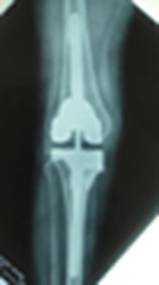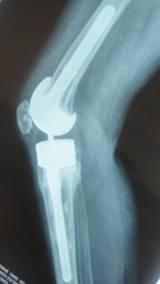- +91 9820036852
- sanjeev.jain@hiranandanihospital.org
- drsanjain@hotmail.com
Revision Knee Replacement
When one compartment of knee joint is arthritic then replacing this part with metal and plastic joint known as unicompartmental knee replacement.
Revision Knee Replacement

Although today’s implants are designed to last many years, it’s possible that at some point in the future - typically 15 to 20 years or more prosthetic will break or wear out. If patient is overweight or engages in high impact activities such as running or court sports, the device may fail sooner. When a knee replacement no longer functions correctly, revision surgery is often required. During this procedure, a surgeon replaces the old device with a new one. Revision surgery isn’t something to take lightly. It is more complicated than a primary (or "initial") total knee replacement (TKR) and entails many of the same risks
Why Revision Surgery is More Complicated Than Initial
Surgery
A revision procedure is typically more complex than the original knee replacement surgery because the surgeon must remove the original implant, which would have grown into the existing bone. In addition, once the surgeon removes the prosthesis, there is less bone remaining. In some instances, a bone graft—transplanting a piece of bone transplanted from another part of the body or from a donor—might be required to support the new prosthesis. A bone graft adds support and encourages new bone growth. However, the procedure requires additional preoperative planning, specialized tools, and greater surgical skill. The surgery takes longer to perform than a primary initial knee replacement.
If a revision surgery is necessary, patient will experience specific signs. Indications of excessive wear or failure include: diminished stability and/or reduced function in the knee; increased pain or an infection (which usually occurs soon after the initial procedure); or a bone fracture or outright device failure. In other cases, bits and pieces of the prosthetic device may break off and cause tiny particles to accumulate around the joint.
Why do implants fail?
There are several reasons for the failure of knee implants. Some of these reasons include wear, loosening, infection, fracture, instability, and patient related factors:Wear and Loosening:
Properly functioning implants depend on their appropriate fixation to the bone; fixation is usually achieved by cementing the implant onto the bone. Some surgeons prefer to use biologic (non-cemented) fixation.
Although implants are firmly fixed at the initial knee replacement surgery, they may become loose over time. Friction caused by the joint surfaces rubbing against each other wears away the surfaces of the implant, creating tiny particles that accumulate around the joint. In a process called aseptic (non-infected) loosening, the bond of the implant to the bone is destroyed by the body's attempt to digest the wear particles. During this process, normal bone is also digested (a condition called osteolysis), which can weaken or even fracture the bone.
When the prosthesis becomes loose, the patient may experience pain, change in alignment, or instability. Aseptic loosening is the most common mode of failure of knee implants.
Infection:
Infection is a devastating complication of any surgical procedure. In total knee replacement, the large foreign metal and plastic implants can serve as a surface for the bacteria to latch onto, inaccessible to antibiotics. Even if the implants remain well fixed, the pain, swelling, and drainage from the infection make the revision surgery necessary. With current surgical techniques and antibiotic regimens, the risk of infection from total knee replacement is less than 1%. Revision surgery of the infected knee takes several forms. Depending on the degree of infection and damage, the decision is made to either perform a simple washout of the knee with component retention or complete exchange of the implants.
In most cases of infected TKR, two separate operations are required: first to remove the old prosthesis and insert a block of cement with antibiotics (known as an antibiotic-impregnated cement spacer) and a second surgery to remove the spacer and insert a new prosthesis. Intravenous antibiotics are given during this period to eradicate the infection.
Fractures:
The type and extent of the fracture will determine if revision surgery is needed. Peri-prosthetic fractures (fractures around the knee implants) that disrupt the fixation or the stability of the implant may require revision surgery.
Instability:
Instability occurs when the soft-tissue structures around the knee are unable to provide the stability necessary for adequate function during standing or walking. Instability may be the result of increased soft-tissue laxity (looseness), inadequate flexion of the implants, or improper positioning or alignment of the prosthesis. Pain and/or a sense of “giving away” of the knee may alter knee function and require revision surgery.
Patient-Related Factors:
Age, activity level, surgical history, and weight can contribute to implant failure. Younger, more active patients have a higher rate of revision than older, less active patients. Obese patients have a higher incidence of wear and loosening. Patients with previous knee surgeries are at higher risk for infection and implant failure.
When do you need revision knee surgery and what are the signs?
A failed knee implant is usually indicated by an increase in pain or a decrease in knee function. Persistent pain and swelling can indicate loosening, wear, or infection, and the location of the pain can be all over the knee (generalized) or in one particular area (localized). The decline in knee function may result in a limp, stiffness, or instability. Patients who demonstrate these symptoms and signs may require revision joint surgery.
What do you need to do prior to revision surgery?
When the decision for revision knee replacement is made, standard assessments are performed, including x-rays, laboratory tests, and possibly other imaging modalities like bone scans, CT scans, or Magnetic Resonance Imaging (MRI) studies. X-rays may demonstrate a change in the position or condition of the components. MRI helps to determine the cause, location, and the amount of bone loss before surgery. Aspiration of the knee (joint fluid removed with a needle) may be required if infection is suspected. This aspirated fluid will then be sent to a laboratory for analysis to identify the specific type of infection.
What happens during surgery?
Most revision total knee replacements take longer to perform than primary procedures (about two to three hours). The first step is removal of the implant. If there has been significant bone loss, bone grafts may be required to fill the voids. Bone grafts can be either autograft (your own bone taken from another site of your body) or an allograft (bone tissue from another person obtained from a bone bank). In some cases, metal wedges, wires or screws may be used to strengthen the bone. Finally, specialized revision knee implants are inserted. Temporary drains are usually placed to collect any fluids or blood that may remain after surgery.
What about after surgery?
Post-operative care after knee revision surgery is very similar to the care of a primary knee replacement. This includes a combination of physical therapy, blood management, and pain medication as necessary. Antibiotics and some method of blood clot prevention will be continued in the postoperative period. A brace or splint may be used to protect the joint after the surgery.
Recovery time after revision knee surgery varies; some patients take longer to recover. In most cases, physical therapy will be initiated within 24 hours of the procedure. In some cases, protective weight bearing, such as Partial Weight Bearing (PWB) or Toe Touch Weight Bearing (TTWB), is needed to promote bone healing. Therapy will usually continue for up to three months following the surgery. Assistive devices, such as a walker or crutches, will be used early in the convalescence period, and patients will progress to a cane or walking without any assistance as their condition improves.
What are the risks and complications?
Any surgery can have potential complications. The complexity of revision joint surgery increases the chance of surgical complications. Possible complications include:
Infection, bleeding, damage to nerves or blood vessels, and intra-operative fractures can be minimized by using antibiotics before and after surgery, sterile surgical techniques and utilizing well-planned surgical exposures. Similar to primary TKR, some mild swelling of the knee or ankle may be present after surgery for as long as three to six months. Swelling can be treated by elevating the leg, applying an ice pack, and wearing compression stockings. Prior medical conditions, such as heart and lung complications, or stroke conditions, can be aggravated by a revision procedure. These conditions may also develop in patients after revision surgery. Very rarely, death can occur. The decision to perform revision joint surgery is made when the benefits of pain relief and functional improvement outweigh the risk of potential complications.
What should you expect after surgery?
Greater than 90% of patients who undergo revision procedures can expect to have good to excellent results. Although expected outcomes include pain relief with increased stability and function, complete pain relief and restoration of function is not always possible. Up to 20% of patients may still experience some pain following revision knee surgery. This can persist for several years after the procedure.
What are the alternatives to revision surgery?
Alternatives to revision knee surgery are rarely used, since they can sometimes be more complex and lead to worse results than revision surgery. One alternative to knee revision is arthrodesis or knee fusion. Pain may be relieved, but at the expense of keeping the knee in a straight, non-bending position. Alternative procedures such as amputations may be used in cases of severe joint infections that cannot be eradicated. After weighing the alternatives, considering the higher rate of complications as compared to primary knee replacement, most patients and physicians prefer revision surgery to other surgical options.
Conclusion
Although total knee replacement is a highly successful operation in the majority of patients, some procedures will fail. Certain signs and symptoms such as an increase in pain or a decrease in knee function may be indicative of joint failure. There are several reasons for the failure of knee implants such as wear, loosening, infection, fracture, or instability.
Advanced techniques and materials for revision knee surgery usually allow for substantial pain relief and improved function; however, this may not always be possible. Revision TKR is a complex procedure that requires an experienced surgeon and proper pre-operative planning to achieve satisfactory outcomes.

